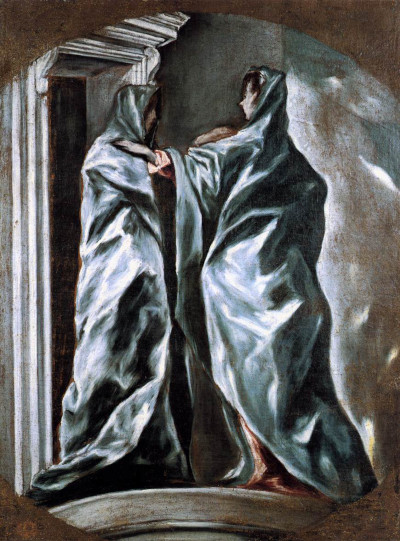Visitation is an artwork by El Greco which was completed in 1609–1613. The artist was prolific in the final years of his life, but did call upon the services of his workshop in order to keep up with the increasing demands placed upon him.
The dimensions of this piece are 98cm in height, by 72cm in width but the shape of the canvas is unusual for El Greco. Both the top and bottom are curved in order to meet the requirements of the commission at the time. The artist would regularly produce paintings to be hung in religious institutions but normally rectangular canvases would suffice. In this case there was clearly a specific location in which Visitation was intended, and that the canvas would be installed in a similar manner to how artists might paint directly onto plaster around architectural details. Isabel de Oballe spoke directly to El Greco at the time and explained that a piece was needed for the church of San Vicente in Toledo, Spain. She specifically mentioned that it must be on a circular canvas, with a matching frame and El Greco agreed to this request. She mentioned some of his other artworks and wanted something similar, helping him to understand precisely what was needed for this project. The loose date of 1609-1613 does not mean that the painting took years to complete, but rather is an approximate date in which historians are confident that the project was carried out at some point in this period. Most likely, the artist would have completed everything within a period of just several months.
The content displayed in this work refers to the visitation of Saint Elizabeth and the painting can today be found in its new location of Dumbarton Oaks in Washington, D.C., USA. It is therefore one of the few items from this artist's career to reside today in the US, with most still present in Europe. Spain serves his career well, with other items to be found in the UK, France and Italy. Interest in his work from the public is considerable and his expressive approach is just as popular today as it ever has been. The Visitation may not be one of the artist's most famous paintings, but it is an important addition to this respected art collection, bringing elements of the Spanish Renaissance to local American eyes. It also contains some of the signature elements of his style, with white paint delivering light on the drapes of material. He also produced many portraits across his career. The decision to have the subject with her back to us is perhaps connected to the Mannerist approach of that era, and was something he did several times.
Toledo would play an important role in his life, having moved there in 1577. The landscape of this region appeared across the background of many paintings. He also met many patrons in this region and was never short of work for himself and his workshop. Although many items from his time here have been dispersed across the world, such as Visitation, many still reside there today. There is also a museum set up in his name which continues to teach new generations about his achievements as an artist, as well as his strong connection to Toledo itself. His life also impacted Crete and Italy too, and his legacy extends to those locations as well. He remains one of the most important artists from 16th and 17th century European art, with a strong following amongst the general public.




